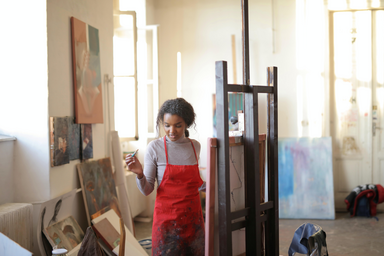There is a common misconception in art that has been perpetrated for years, which is that there were very few women artists in art history. For a while I thought this to be true, so it is an easy trap to fall into. However, now that I know better, I am happy to report these rumors to be completely false. There were women artists, they just weren’t as well known or appreciated in their time like their male counterparts. The spaces that art occupied were challenging and sometimes nearly impossible for women to engage with, but that didn’t stop them. The following group of women are female artists that deserve to be household names.

Suzanne Valadon (September 23, 1865-April 7, 1938)
This French painter truly made a name for herself as she was the first ever woman painter accepted into the Société Nationale des Beaux-Arts. However, after her death in 1938, her work went unnoticed for decades. Valadon was a skilled painter hanging with the famous contemporaries of her time. Her interest in the female form made its way into her work as she emphasized depicting unidealized female nude. Valadon’s work functioned to show the female body as it truly was and embrace the true female experience.

Levina Teerlinc (1510-June 23, 1576)
Teerlinc is the perfect example of women painting in a time that people believed women weren’t painting. She was Flemish Renaissance miniaturist who was a court painter for many English monarchs. Her art is highly debated in the art community as disagreements regarding the actual responsibilities she had while working on this court arise. Before starting work with the courts, her early years would have been spent practicing in her father’s illumination studio. Teerlinc’s life was spent engaging with art in a variety ways, which made her especially skilled and valued in the English courts.
Frida Kahlo (July 6, 1907-July 13, 1954)
Although, Kahlo has become much more popular in more recent years, I could never write a piece on female artists and exclude her. One of my personal favorites, Kahlo explored many subject areas ranging in topics from infertility, cultural heritage, sexuality, and identity, just to name a few. Initially hoping to be a doctor, a horrible accident shattered this dream leaving her open to explore the possibility of becoming an artist. At first she used art as a way to create anatomical drawings, once she was set up with a mirror and paints, she began using art to explore her own image. Kahlo’s resilience throughout her life made her into the artist she was meant to become.

Mary Cassatt (May 22, 1844-June 14, 1926)
Cassatt maintains a place among the Impressionist artists, many of whom are notable men. She changed that perspective creating images of women from a female perspective. Depicting women in their everyday life, she hoped to capture the authenticity of the female figures she presents. She specialized in depicting images of the bond between mother and child. Much of her work focuses on the intimacy of the private lives of women. Although she is considered an American artists, she relocated to France, finding a spot among the Impressionists, displaying her work alongside theirs.
Kara Walker (November 26, 1969-)
Another one of my favorites, Walker uses installation art to make statements regarding a variety of social issues including race and racism, gender, sexuality, and identity. Something so unique about Walker’s art is the enchantment viewers receive from looking at the pieces on a surface level. She pairs colorful lights with black silhouettes creating a visually attractive piece. However, once you start to look a little more at what is actually going on you become horrified the actions of the silhouettes. Using her art to discuss complex societal issues is ingenious because unless you truly engage with her work, you would not be able to see the masterful way she reveals all the horror bubbling under the surface.
As an art historian I love engaging with work created by women because sometimes I feel it slips through the cracks. One of the best parts about what I do is research and it makes me hopeful that even though some of this art went unappreciated for years, through research and dedication we can find more gems like these women.




